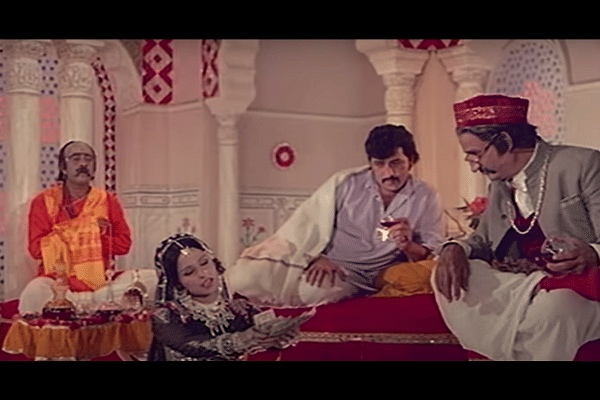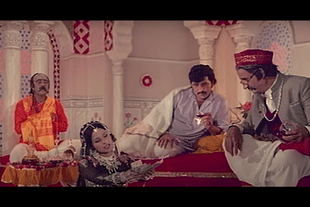Culture
Why Bollywood Pushes Hateful Stereotypes Of Hindus Created And Cemented By Foreign Colonial Rule
Swarajya Staff
Sep 30, 2020, 05:39 PM | Updated 01:51 PM IST
Save & read from anywhere!
Bookmark stories for easy access on any device or the Swarajya app.


A Hindu priest clad in saffron clothes, wearing rudraksha, while chanting his mala is watching the Mujra. Kothe Wali in her song exposes the fake religion of idol worship of the pandit, calls it a blot on the society. His religion loots. He is a harjaai. He has made “paththar” a god, in whose protection he commits thousands of crimes. He is not a human. He has nothing to be proud of. His work, his religion are so bad that the nature itself is embarrassed.
The above scene is from the 1978 film Ganga Ki Saugandh by Sultan Ahmed. The song was sung by Lata Mangeshkar. The movie stars Amitabh Bachchan and Rekha.
A social media account Gems of Bollywood (@gemsofbollywood) opened recently has quickly gained traction for exposing the hateful stereotypes promoted by Bollywood.
In its description, the channel claims to expose the “hidden gems from the largest film industry of the world”.
Bollywood is routinely criticised for the objectification of women, nepotism, structural injustices, as well as the representation of Muslims — the trope of “good” Muslim character who fights the “bad” Muslim characters.
However, the area of stereotypical representation of Hindus and Hinduism, in line with their historical hateful characterisation under the foreign imperial rule, never quite got the same attention.
The foreign imperial discourse caricatured Hindus as regressive, weak, effeminate, slavish people who deserved to be subjugated, and stereotyped the oldest continuing civilisation of the world as hideous, grotesque, ignoble, disgusting. Hinduism was the grossest, darkest and most degrading system to have ever existed on Earth.
There were repeated calls and attempts for its complete annihilation — ‘such a religion as the religion of the Hindoo, the [British] government were bound, as in the sight of God, to put down with all the strength of their hand’.
Such characterisation, the underlying ideology, and the resulting persecution of Hindus precede the British Raj.
From Delhi Sultanate and Mughals to the 19th century Muslim movements; from the politics of the Muslim League and the Partition to the present day extremists, the Islamist supremacist rhetoric — including Ghazwa-i-Hind, Dar-ul-Islam, and hatred against polytheists and idol-worshippers — has essentially remained intact.
An individual ruler could be personally more or less of a bigot, but ideological hatred for Hindus was always present as a powerful force.
The Hindu-hate ideology stereotypes Hindus as a disease, a gangrenous limb and Hinduism as darkness, effeminacy to cured by the light of a superior, manlier race belonging to a better family of religions (very much like Nazism stereotypes Jews).
Unfortunately, Bollywood has only continued what has been going on for centuries. Bollywood movies have become an example of the resilience of the colonial stereotypes — the cunning and spineless pandit; the idiot brahmachari; the ‘oriental despot’ Thakur; the greedy Baniya with no morals; weak, effeminate Hindu’s wife/daughter desperate for a ‘real’ man — and Hinduism portrayed vivaciously as the scene of their crimes.
Before we list some other examples, something needs to be said about the politics of ‘social reform’ that has been a convenient vehicle for the colonisers and their apologists to legitimise Hindu-hatred.
Of course, like any other civilisation, culture and group, the history of Hindus and Hinduism is not perfect (as the 19th century reformers and many scholars have pointed out, Hinduism itself has a long and rich tradition of questioning, debate, reform, tolerance and pluralism).
The critique of the social reform argument of the imperialists is not that the Hindus are absolutely above criticism, but that the same technique of reducing a people and an ancient civilisation to few stereotypes, one, would leave the imperialists themselves in no position to raise fingers on others; two, is riddled with inaccuracies; and three, is harmful for the real social change.
What makes the imperialists’ social reform argument hollow is their own glaring hypocrisy in its implementation. If they truly cared about social reforms, why the reluctance to push for similar reforms and “progressive” steps in own country/community?
The British gave Indian women separate electorate in 1920 — something they never gave to the women of Britain. The Muslims in India were also given separate electorate and personal laws by the British, but in the territory of Britain, to this day, even niqah is not recognised. Are minority rights not important in Britain?
The so-called social reform agenda was actually about imperial power, Hindu-hatred and divide and rule.
It was opportunistic and changed according to the imperial priorities — caste in Hinduism was an abomination but appropriation of caste as a vehicle of mass conversion to Christianity was legitimate.
In fact, caste discrimination among the non-Indics is deliberately invisiblised to further the Hindu-hate agenda, much like the internal conflicts of these groups are suppressed to highlight only the ‘Us versus Hindu’ cleavage.
The imperial social reform argument is further exposed when contrasted to the Indian-owned and Indian-led social reform efforts of the nationalists and freedom fighters like Gandhi, Vivekananda, Ambedkar etc.
These leaders also warned against the aggressive and imperial characteristics of self-proclaimed superior, manlier religions.
So, as we watch the compilation by Gems of Bollywood, we should question whether the people who wrote these scenes are genuinely committed to the principles of equality and non-discrimination, or just furthering the ideological Hindu-hatred masked by the social reform trope.
We should also question the veracity of their commitment to social reform, which seems to find Hindu-hatred necessary for progress but at the same time continues other offensive, regressive depictions, say, of female characters.
Does the alleged commitment of the movie-maker against ‘superstition’ only extend to Hindu temples, idols and depiction of Hindu religious persons as criminals, or extends to questioning all faiths, and all beliefs in general?
In a country where most indigenous cultures practice what the imperialists pejoratively call “idol-worship” and “polytheism”, where thousands of Hindu women have been targeted for rape, abduction, enslavement; where countless Hindus temples have been demolished and desecrated; where Hindus have been burnt alive on stake, tortured to death in the name of one true god and one true faith, it is confounding that the “idol-worship” continues to be represented as the paragon of what can be wrong with a religion.
From a scientific perspective, is it the case that non-polytheistic, non-idol worship has been validated any more than the others? Any other worship of god is as ‘non-scientific’ as idol worship, then why do self-proclaimed champions of scientific thinking exclusively attack Hindu “idol-worship”?
In Hindu philosophy, continuity and change; nothing and everything; accessing god through diverse vigrahas and ways and characterisation of god as sanatana or akal, all encompassing, all inclusive, omnipresent, omnipotent, are two sides of the same coin.
A separate article can be written about ‘idol worship’ and unity in diversity in the Indian civilisation, but for now, the question is, why Bollywood continues to copy the colonial hateful characterisation of Hindus and Hinduism?
Self-aware, principled criticism is what differentiates a true liberal from an imperialist-colonialist who is out to degrade and stereotype others.
Some like Sultan Ahmed in Ganga Ki Saugandh go out of their way to portray their own religion and its followers as the only good people, while Hindus as either bad people or the victims of Hinduism.
The message is clear — a good Hindu is either a dead Hindu or a not-Hindu.
Here are a few scenes of Bollywood's hateful stereotypes which have been curated by @GemsOfBollywood.
Hero cuts his Shikha, fed up of casteist Thakur-Banias-Pandit nexus, where only Khan Sahab and Kallu are humans.
— Gems of Bollywood (@GemsOfBollywood) September 26, 2020
Film Ganga ki Saugandh by Sultan Ahmed pic.twitter.com/J9QTZ0fgOU
Baniya, Pandit and Thakur together go to Kotha.
— Gems of Bollywood (@GemsOfBollywood) September 29, 2020
Even Mujra wali knows they are inhuman. She describes each of them through a song sung by Lata Mangeshkar.
The laalchi Baniya has destroyed many a lives in his greed of money.
Film Ganga ki Saugandh by Sultan Ahmed pic.twitter.com/B1gIVBYUSm
Next, the Kothe Wali exposes the Pandit, who is listening to the Mujra clad in his bhagwa clothes and chanting his mala.
— Gems of Bollywood (@GemsOfBollywood) September 29, 2020
His fake religion of idol worship is a blot on the society. His religion loots. He is a harjaai. pic.twitter.com/rTzCEHPUGc
The evil Banias of Hindus. Obsessed with money and tasty food. Even his daughter has no seek love in his servant Jagdeep.
— Gems of Bollywood (@GemsOfBollywood) September 27, 2020
Film Ganga ki Saugandh by Sultan Ahmed pic.twitter.com/cYsNsrfOGC
You worship Kali?
— Gems of Bollywood (@GemsOfBollywood) September 26, 2020
You are criminal.
You kill people.
You are Kala in and out.
You are biggest villain.
Dialogues written by Anwar Khan and Nusrat Sayyed for film Jungbaaz, 1989 pic.twitter.com/itNtt52atk
The evil Brahmins of Hindus. Fraud and greedy to the core. If not for Islam, who will save the gullible poor Hindu?
— Gems of Bollywood (@GemsOfBollywood) September 27, 2020
Film Ganga ki Saugandh by Sultan Ahmed pic.twitter.com/O7wNbLNLtQ
"Shiv Shambhu. Shiv Shambhu. Shiv Shambhu."
— Gems of Bollywood (@GemsOfBollywood) September 27, 2020
*Discusses a murder plan*
"Shiv Shambhu. Shiv Shambhu. Shiv Shanbhu."
Film Ilaaka by Izaz Selwal. Written by Javed Siddiqui pic.twitter.com/OuwXeR0qHS
"Muthuswami bada harami"
— Gems of Bollywood (@GemsOfBollywood) September 28, 2020
A Brahmin from south of India typecast as a loony dancer. An overall vulgar song, sung by industry veterans.
Thanks to this number, film Vidhata by Subhash Ghai became a blockbuster in 1982.
And yes, Shammi Kapoor won a Filmfare award for this role pic.twitter.com/hhw9wzFntz
"Ishwar and Crime were born out of fear," says Lala, the most dreaded gangster of Mumbai who sports Tilak, wears Rudraksh, touches feet of elders, is heavily into Pooja Path.
— Gems of Bollywood (@GemsOfBollywood) September 28, 2020
Eerie sound of sitar in the background.
Film Angaarey by famed Mahesh Bhatt. Written by Javed Siddiqui pic.twitter.com/SSveTLn2IP
Foolish Pandit. Tharki Thakur. Idiot Brahamchari. Stereotypes galore
— Gems of Bollywood (@GemsOfBollywood) September 28, 2020
Film Padosan by Mehmood Ali, NC Sippy pic.twitter.com/oQzSJGys3L
Mahesh Bhatt on Islam and peace:
— Gems of Bollywood (@GemsOfBollywood) September 25, 2020
"à¤à¤¸ सॠà¤à¥à¤¨ à¤à¤°à¤¾à¤¬à¤¾ दà¥à¤à¤¾ नहà¥à¤ à¤à¤¾à¤¤à¤¾. à¤à¤¸à¥ तॠमसà¥à¤à¤¿à¤¦ à¤à¤¾ मà¥à¤²à¤µà¥ हà¥à¤¨à¤¾ à¤à¤¾à¤¹à¤¿à¤ था"
Film: Thikana. 1987 pic.twitter.com/wQ1q93pFfj
Akhara pahalwan, who wears saffron, pulls skirt of school girl. Hanuman moorti in backdrop. No other pahalwan intervenes or objects.
— Gems of Bollywood (@GemsOfBollywood) September 30, 2020
This from promo video of Commando 3 written by Junaid Wasi and Darius Yarmil. 2019 pic.twitter.com/DmNnv5qkEk





